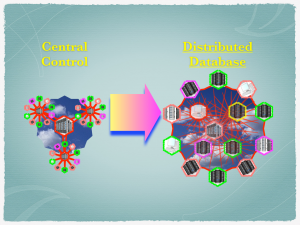Blockchain
”Gadget”というと『小さな気の利いたモノ』という印象を受け、どちらかといえば形のあるハードウェアを想像する。新しいハードウェアが近ごろ目にとまらなくなってきた気がするが、その中 “おっ” これおもしろいな〜と思ったのが “Blockchain”。ブロックチェーンは形がないソフトウェアや概念というモノであり、小さくはないが、『気の利いた』モノ であると思うので取り上げてみた。
メインフレームにターミナルが多数つながった中央処理システムの70〜80年代。パソコンや汎用コンピューターの台頭により分散処理・管理が進んだ80〜90年代。そしてクラウドコンピューティングが広がり、クラウド一極での中央管理に昨今戻っている。一極管理に対して分散管理の概念を進めたのがブロックチェーン。
ブロックチェーンはデータを中央で集中管理するのではなく、ネット上の第三者の機器を利用した『ブロック』が形成し、それぞれの『ブロック』がネットという『チェーン』で繋がるという構成。各『ブロック』は暗号処理されたデータを格納しており、相互に監視してデータの保全を保つ仕組みとなっている。

ブロックチェーンの考えは”Satoshi Nakamoto”により考案された”Bitcoin”運用のために生まれた。発表された論文は他所で掲載されているので要約部分(Abstract)のみを以下に転記する。
Abstract.
A purely peer-to-peer version of electronic cash would allow online payments to be sent directly from one party to another without going through a financial institution. Digital signatures provide part of the solution, but the main benefits are lost if a trusted third party is still required to prevent double-spending. We propose a solution to the double-spending problem using a peer-to-peer network. The network timestamps transactions by hashing them into an ongoing chain of hash-based proof-of-work, forming a record that cannot be changed without redoing the proof-of-work. The longest chain not only serves as proof of the sequence of events witnessed, but proof that it came from the largest pool of CPU power. As long as a majority of CPU power is controlled by nodes that are not cooperating to attack the network, they’ll generate the longest chain and outpace attackers. The network itself requires minimal structure. Messages are broadcast on a best effort basis, and nodes can leave and rejoin the network at will, accepting the longest proof-of-work chain as proof of what happened while they were gone.
信頼保証されたオンライン支払いを実現するためのブロックチェーンは中央集権の一極管理を開放し、分散管理することを可能とした。現在広く利用されるようになった金融分野以外に、分散管理の考えを拡張して多方面に利用する考えが広がっている。
主に利用されている仮想通貨(Cryptocurrency)を含め